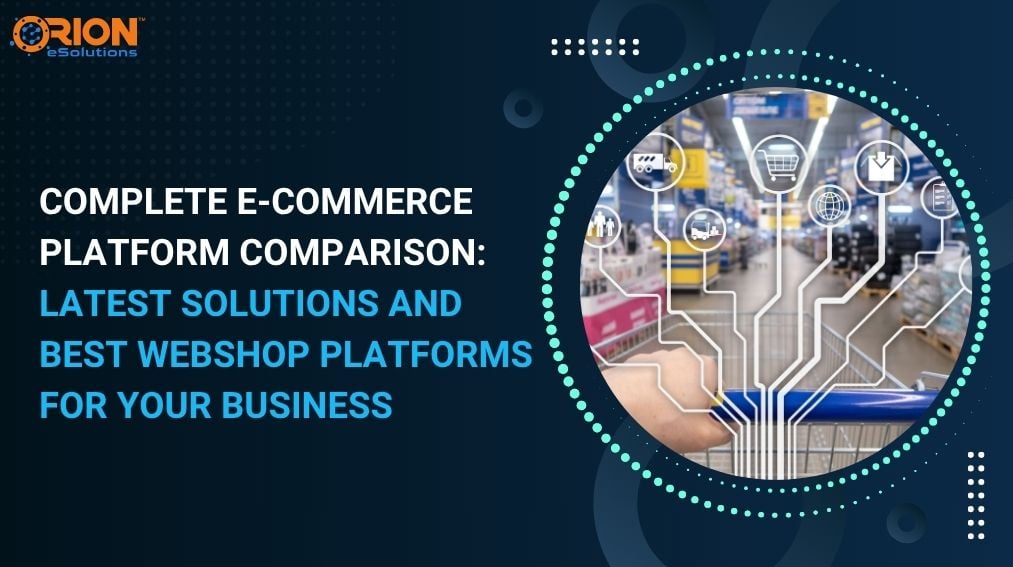Selecting the right e-commerce platform is crucial for establishing a successful online business. With numerous options available, such as Shopify, Magento, WooCommerce, and nopCommerce, each offering unique features and capabilities, making an informed decision can be challenging. This guide provides a comprehensive comparison of the latest e-commerce solutions, helping you identify the best webshop platform to meet your specific business needs and drive growth.
What is an ecommerce platform
An ecommerce platform is the core technology that allows businesses to build, manage, and run online stores. It’s the digital foundation that transforms a traditional business into a fully operational online retail presence. These software solutions provide the tools needed to sell products or services online, from showcasing items to handling payments and managing customer interactions. This often falls under broader custom web development solutions.
A digital commerce platform combines essential components that work together. The storefront acts as a virtual display, presenting products with descriptions, images, and pricing. Behind the scenes, inventory management systems track stock, automate reordering, and sync data across sales channels. Payment processing ensures secure transactions, while customer management tools help build relationships through personalized experiences and marketing.
Modern ecommerce platforms have evolved beyond simple online catalogs. Today’s solutions include features like AI for product recommendations, mobile-responsive designs, and analytics that provide insights into customer behavior and sales. These platforms also support omnichannel selling, allowing businesses to maintain consistent experiences across websites, mobile apps, social media, and physical stores.
The advantage of modern ecommerce solutions is their accessibility. Small startups can launch online stores quickly using intuitive interfaces, while large businesses can use customization options to create unique shopping experiences. Whether selling crafts or managing a global retail operation, there’s an ecommerce platform designed to meet specific needs and scale with growth.
Understanding the different types of platforms available is the next step in making an informed decision.
Online store platforms – types and deployment models
Understanding the different types of online store platforms and how they’re deployed is important for making informed decisions about your ecommerce setup. Each approach has advantages and challenges, catering to businesses with different technical skills, budgets, and operational needs.
Hosted ecommerce platforms are the most user-friendly option. These cloud-based solutions handle the technical aspects, including server management, security, and performance. By choosing a hosted platform, you’re renting space in a managed digital environment. The provider handles data backups and security certificates, allowing you to focus on growing your business.

Hosted solutions offer convenience. They provide automatic updates with new features and security improvements. They also offer built-in scalability, meaning your store can handle traffic spikes without manual adjustments. Platforms like Shopify have built ecosystems around their offerings, featuring app marketplaces and theme libraries.
Self-hosted platforms offer complete control over your ecommerce environment. With this model, you get your own web hosting and install the ecommerce software on your server. This appeals to businesses that need customizations or want to control their data and infrastructure. However, self- hosting requires more technical knowledge and maintenance.
SaaS ecommerce platforms combine convenience and functionality, delivering software as a service through subscriptions. These solutions combine the ease of hosted platforms with more customizable options. They offer tiered pricing, allowing businesses to start small and upgrade as needed, making them attractive for companies with changing requirements.
Open source ecommerce platforms offer customization by providing access to their code. This allows developers to modify the platform to meet specific needs. While the software is free, implementing and maintaining an open source solution often requires technical expertise or development services. The trade-off is control over functionality, appearance, and data management. As you consider these different deployment models, it’s equally important to understand the specific features and capabilities that define the best webshop platforms.
Best webshop platform features and capabilities
Selecting the best webshop platform requires evaluating features that align with your business goals. Successful online stores are built on platforms that integrate essential ecommerce functions while allowing for growth as market conditions change.
Security and payment processing are essential for any online store. Modern ecommerce platforms must provide secure checkout experiences and support various payment options. This includes integration with credit card processors, digital wallets like Apple Pay and Google Pay, and buy-now- pay-later services. The platform should handle security compliance automatically, protecting payment information.
Inventory management is crucial, especially as businesses grow. Platforms offer real-time stock tracking, automated low-stock alerts, and integration with suppliers for reordering. Advanced features include variant management for products with options, bundle creation for promotions, and backorder handling.
The modern retail landscape requires omnichannel capabilities that unify online and offline experiences. Leading ecommerce platforms integrate with point-of-sale systems, maintaining consistent inventory and customer data across touchpoints. This extends to social media, marketplaces, and mobile apps, creating a cohesive brand experience.
Marketing and customer engagement tools have become sophisticated, encompassing customer journey management. The best platforms include SEO optimization, social media integration, abandoned cart recovery, and customer segmentation. Advanced features might include loyalty programs, personalized recommendations, and automated email sequences.
Analytics and reporting provide insights for data-driven decisions. Platforms offer sales reports, customer behavior analysis, and performance metrics. This data should be presented through dashboards that make complex information accessible.
Mobile optimization is essential, as mobile commerce grows. The best webshop platforms provide responsive designs, mobile-specific checkout flows, and progressive web app capabilities.
Scalability and performance optimization ensure that your platform can handle growth. This includes content delivery networks for fast loading times, database optimization for large product catalogs, and server architecture that can handle traffic spikes. For startups, selecting a platform that balances these features with affordability is key.
Small business ecommerce platforms – top solutions for startups
Launching an online business as a startup requires selecting a platform that balances affordability, ease of use, and growth potential. The best ecommerce platform for beginners provide intuitive interfaces and essential features to establish a professional online presence and drive sales.
Shopify is a popular choice among small business owners. It offers a balance of user-friendliness and features, making it accessible to beginners while providing room for customization as businesses grow. The platform’s strength is its ecosystem of themes and applications, allowing entrepreneurs to create professional stores without hiring developers. Shopify handles hosting, security, and updates, allowing business owners to focus on product development and customer acquisition.

The platform’s pricing structure is attractive for startups, with basic plans that include everything needed to start selling online. Transaction fees are competitive, especially when using Shopify’s payment system, and the platform scales as sales increase. The support resources, including documentation, tutorials, and community forums, help newcomers learn quickly.
Square Online is a compelling option for businesses already using Square’s point-of-sale systems or those seeking a free entry point into ecommerce. The platform offers a free plan that includes basic online store functionality, making it ideal for testing ecommerce without financial commitment. The integration between online and offline sales through Square’s ecosystem provides omnichannel capabilities.
Wix represents the website builder approach to ecommerce, appealing to entrepreneurs who prioritize visual design. The platform’s interface makes it possible to create visually appealing online stores without coding knowledge. While Wix may not offer the same depth of ecommerce-specific features as dedicated platforms, it excels in providing mobile-responsive designs that help small businesses establish strong brand identities.
WooCommerce is worth considering for businesses already familiar with WordPress or those seeking customization. As a free plugin that transforms WordPress websites into online stores, WooCommerce offers flexibility and cost-effectiveness. However, this approach requires more technical involvement, as users must manage their own hosting, security, and updates. The trade-off is control over functionality and the ability to leverage WordPress’s ecosystem of plugins and themes.
BigCommerce positions itself as a growth-focused platform that eliminates transaction fees while providing enterprise-level features at small business prices. The platform includes SEO tools, multi- channel selling, and analytics. While the interface may be more complex than some alternatives, the feature set makes it a good choice for startups planning rapid expansion.
Ecwid allows businesses to add ecommerce functionality to existing websites, social media pages, or marketplaces. This flexibility makes it ideal for businesses that want to maintain their current web presence while adding online selling capabilities. The platform offers a free plan for up to five products, making it perfect for testing ecommerce concepts or selling small product lines.
When evaluating platforms for small business use, consider factors beyond cost and ease of setup. Look for solutions that offer room for growth, provide customer support, and include features like mobile optimization, SEO tools, and payment processing. The best online sales platform for your startup will depend on your industry, technical comfort level, and business goals. For larger operations, enterprise ecommerce platforms offer a different set of capabilities.
Enterprise ecommerce platforms for large-scale operations
Enterprise-level businesses need digital commerce platforms capable of handling complex operations, high transaction volumes, and intricate business processes. These solutions offer tools for managing global operations, product catalogs, and customer relationships across channels and markets.
Adobe Commerce, formerly known as Magento, offers enterprise ecommerce capability. This platform provides flexibility and customization, making it the preferred choice for businesses with unique requirements. The platform excels in handling large product catalogs, supporting multiple websites from a single installation, and providing B2B functionality including custom pricing and approval workflows.
The strength of Adobe Commerce lies in its modular architecture, which allows businesses to implement the features they need while maintaining performance. Inventory management capabilities support scenarios like drop-shipping and pricing rules. The platform’s API framework enables integration with existing enterprise systems including ERP, CRM, and warehouse management solutions.
Salesforce Commerce Cloud leverages Salesforce’s customer relationship management ecosystem to deliver personalized shopping experiences. This platform excels in AI-driven personalization, using machine learning to optimize product recommendations and marketing campaigns. The platform’s strength in customer data management makes it valuable for businesses focused on personalized experiences.
The platform’s omnichannel capabilities enable businesses to maintain customer experiences across web, mobile, social media, and physical retail locations. Advanced features include predictive analytics for demand forecasting, segmentation tools for targeted marketing, and order management systems that can handle fulfillment scenarios.
SAP Commerce Cloud brings enterprise resource planning expertise to ecommerce, offering integration with SAP’s business software ecosystem. This platform excels in scenarios where ecommerce operations need to integrate with back-office systems or supply chain management. The solution provides B2B functionality, including pricing structures and contract management.
Oracle Commerce Cloud focuses on delivering customer experiences through personalization and optimization. The platform includes testing and optimization tools that enable businesses to improve conversion rates and customer satisfaction. Analytics provide insights into customer behavior, enabling data-driven decision making.
Enterprise platforms distinguish themselves through their ability to handle business requirements that would overwhelm smaller solutions. This includes support for multiple currencies and languages, tax calculation for global operations, pricing rules, and security features that meet compliance requirements.
The total cost of ownership for enterprise platforms extends beyond licensing fees to include implementation and maintenance costs. However, the return on investment can be substantial for businesses that leverage these platforms’ capabilities to optimize operations, improve customer experiences, and drive revenue growth. When comparing platforms, understanding the nuances between solutions like Shopify and WooCommerce is essential.
Shopify vs WooCommerce – comprehensive platform comparison
The choice between Shopify vs woocommerce represents a significant decision in ecommerce platform selection, as these solutions embody different approaches to online retail. Understanding their strengths and limitations helps businesses make informed decisions that align with their technical capabilities, budget, and objectives.
Shopify operates as a hosted solution that handles technical aspects of running an online store. From signup, Shopify provides hosting, security, updates, and maintenance, allowing business owners to focus on product development, marketing, and customer service. This approach makes Shopify appealing to entrepreneurs who want to launch quickly without dealing with technical complexities.
The platform’s strength lies in its ecosystem of themes, applications, and integrations. Shopify’s app store contains extensions that can add functionality, from inventory management to marketing automation. The quality control ensures that most apps work reliably together.
Shopify’s pricing structure is transparent, with monthly subscription fees that include hosting, security, and core functionality. While transaction fees apply when using third-party payment processors, businesses using Shopify Payments can avoid these costs. The platform scales from small startups to large enterprises, with higher-tier plans offering features like analytics and reporting tools.
WooCommerce is a free WordPress plugin that transforms content management systems into online stores. This open-source solution provides customization, allowing businesses to modify their store’s appearance and functionality. The flexibility comes with responsibility, as users must manage their own hosting, security, updates, and maintenance.
The cost structure of WooCommerce can be complex. While the core plugin is free, businesses typically need to invest in premium themes, extensions, hosting, and security measures. Advanced functionality often requires paid plugins, and the total cost can exceed hosted solutions when factoring in development time and maintenance.
WooCommerce’s integration with WordPress provides advantages for content-heavy businesses or those prioritizing search engine optimization. The platform inherits WordPress’s content management capabilities, making it ideal for businesses that rely on blogging or complex product information. The WordPress ecosystem provides access to plugins and themes, though quality and compatibility can vary.
Performance considerations differ between the platforms. Shopify’s hosted infrastructure is optimized for ecommerce, providing fast loading times and uptime. WooCommerce performance depends on hosting quality, theme optimization, and plugin selection, potentially offering speed when properly configured but requiring optimization efforts.
Customization capabilities represent the difference between these platforms. Shopify provides customization options through its theme system, but control remains with Shopify. WooCommerce offers customization since users have access to the code, making it possible to create unique shopping experiences.
The comparison extends to platforms like Magento, which offers enterprise-level capabilities but requires technical expertise. BigCommerce provides a middle ground with hosted convenience and features, while platforms like Squarespace and Wix focus on design-centric approaches.
Understanding how these platforms stack up against each other is crucial for making the right choice.
Support and community resources vary between platforms. Shopify provides customer support, documentation, and a community of developers and users. WooCommerce relies on community support, though documentation and tutorials are available. The open-source nature means that solutions are often freely available, but finding and implementing them may require technical knowledge. Beyond dedicated ecommerce platforms, website builders also offer ecommerce capabilities.
Squarespace vs Shopify and other platform matchups
The landscape of ecommerce platforms includes alternatives that cater to different business priorities. Understanding how website builders compare to ecommerce solutions helps businesses choose platforms that align with their needs, whether prioritizing visual appeal, ease of use, or selling features.
Squarespace has built its reputation on delivering visual designs that appeal to creative professionals and businesses where presentation is important. The platform’s templates are known for their layouts, typography, and visual hierarchy, making it possible to create websites without design expertise.
When Squarespace added ecommerce capabilities, it maintained this design-first philosophy, resulting in online stores that often look polished.
However, Squarespace’s ecommerce functionality doesn’t match the depth of dedicated platforms like Shopify. The platform handles selling features including inventory management and payment processing but lacks the app ecosystem and features that online retailers often require. Squarespace works best for businesses selling limited product lines where visual presentation is crucial, such as art or fashion.
The pricing comparison between Squarespace and Shopify reveals different value propositions. Squarespace’s ecommerce plans include website hosting, design templates, and selling features in a single package, making it cost-effective for businesses that need both a website and online store functionality. Shopify’s pricing focuses on ecommerce features, potentially requiring investments in themes and apps but offering selling capabilities.
BigCommerce positions itself as a growth-focused alternative that eliminates transaction fees while providing enterprise-level features at competitive prices. The platform includes SEO capabilities, multi- channel selling tools, and analytics as standard features. This appeals to businesses that want room to grow without upgrading plans or paying transaction fees as sales increase.
The comparison between BigCommerce and Shopify often comes down to fee structures and included features. BigCommerce’s no-transaction-fee model can result in savings for high-volume sellers, while its built-in features reduce the need for third-party apps. Shopify’s strength lies in its user-friendly interface and app ecosystem, though the costs can accumulate as businesses add functionality through applications.
Wix represents another design-centric approach to ecommerce, offering website building with selling capabilities. Like Squarespace, Wix excels in visual customization and ease of use, making it possible for users to create online stores. The platform’s design intelligence can even generate website layouts automatically based on business type and preferences.
The Wix versus Shopify comparison highlights the trade-off between design flexibility and ecommerce specialization. Wix provides visual customization options and includes website functionality beyond ecommerce, making it suitable for businesses that need web presence management. Shopify’s focus on ecommerce results in selling features, inventory management, and scalability for growing businesses.
Weebly, now part of Square’s ecosystem, offers a website builder approach with ecommerce capabilities. The platform’s strength lies in its connection to Square’s point-of-sale systems, providing omnichannel selling for businesses that operate both online and offline. This integration makes Weebly attractive for retail businesses that want to unify their digital and physical operations.
Each platform’s mobile optimization capabilities deserve consideration, as mobile commerce continues to grow. Shopify provides mobile-responsive themes and a mobile app for store management, while design-focused platforms like Squarespace and Wix ensure that their templates look excellent on mobile devices. The key difference lies in mobile-specific ecommerce features like one-click checkout and mobile payment integration. Understanding the pricing structures of these platforms is also crucial for making an informed decision.
The decision between these platforms depends on business priorities. Companies that prioritize visual design and need selling functionality may find Squarespace or Wix sufficient. Businesses focused on growth and ecommerce features will likely benefit from Shopify or BigCommerce. Those seeking omnichannel integration might prefer Square-based solutions, while companies requiring customization should consider WooCommerce or open-source alternatives.
Shopping platforms pricing and cost analysis
Understanding the cost of shopping platforms requires looking beyond monthly fees to examine the total cost of ownership, including hidden expenses, transaction fees, and additional services that become necessary as businesses grow. A cost analysis helps businesses budget accurately and avoid expenses that can impact profitability.
Hosted ecommerce platforms typically employ subscription-based pricing models that include functionality, hosting, and security in monthly fees. These pricing structures make budgeting straightforward, but businesses must examine what’s included at each tier and what requires investment. Entry-level plans often include basic features for small stores, while advanced functionality may require upgrading to higher-priced plans.
Transaction fees represent an ongoing cost that varies between platforms and payment processing options. Some platforms charge transaction fees on all sales regardless of the payment processor used, while others waive these fees when using their payment systems. The difference can be substantial for high-volume sellers, making it essential to calculate the impact of transaction fees on profitability when comparing platforms.
The hidden costs of ecommerce platforms often surprise new users. Premium themes can cost hundreds of dollars, while essential apps and extensions may require subscriptions that add up. Professional photography, copywriting, and design services represent investments that many businesses need to create competitive online stores. These costs should be factored into platform selection decisions, especially for businesses with limited budgets.
Open source platforms present a different cost structure. While the software itself is typically free, businesses must invest in hosting, security, maintenance, and development work. Quality hosting for ecommerce sites can cost more than basic web hosting due to performance and security requirements. Professional development work for customization and maintenance can represent expenses, though businesses gain control over their platforms in return.
Enterprise platforms involve pricing structures that often include licensing fees, implementation costs, and support contracts. These solutions typically require upfront investments and services, but they provide capabilities that can justify the expense for operations. The total cost of ownership for enterprise platforms should include software licensing, hardware, integration, training, and support costs.
Payment processing costs deserve attention as they directly impact every transaction. Different platforms offer payment processing options with different fee structures. Some provide rates through payment systems, while others allow businesses to use their preferred payment processors. The choice can impact costs, especially for businesses with high transaction volumes.
Scalability costs should be considered when evaluating platform expenses. Some platforms charge based on sales volume, meaning costs increase as businesses grow. Others offer sales within plan tiers, providing scaling costs. Understanding how costs will evolve as your business grows helps avoid platform migrations later. To gain a comprehensive understanding, it’s also important to consider the experiences of other users.
Ecommerce platform reviews and user experiences
Real-world user experiences provide insights into how ecommerce platforms perform beyond marketing promises. Analyzing reviews from business owners reveals the challenges, benefits, and satisfaction levels that influence platform success in online markets.
User reviews highlight the importance of customer support, particularly during moments like payment processing issues. Platforms that provide support through multiple channels tend to receive satisfaction ratings, while those with support options often frustrate users when problems arise. The quality of documentation and community forums also impacts user experience.
Performance and reliability emerge as factors in user satisfaction across platform types. Business owners frequently mention the impact of site speed and uptime on sales conversion, with performance issues potentially costing revenue during shopping periods. Hosted platforms generally receive praise for performance, while self-hosted solutions receive mixed reviews depending on hosting quality and management.
The learning curve associated with different platforms varies, and user reviews often reflect this reality. Platforms designed for beginners typically receive feedback for ease of use but may be criticized for functionality. More sophisticated platforms earn praise for their capabilities but often receive complaints about complexity.
Customization capabilities generate reviews depending on user needs and technical expertise. Business owners with design requirements often express frustration with platforms that limit customization options, while those seeking simplicity may feel overwhelmed by platforms offering customization possibilities. The availability and quality of themes influence user satisfaction, particularly for businesses without design resources.
App ecosystems and third-party integrations receive mention in platform reviews. Users appreciate platforms with app marketplaces that extend functionality without requiring development. However, the cost of apps and compatibility issues between extensions often generate feedback. The popular platforms tend to have app ecosystems with integrations.
Mobile experience reviews have become important as mobile commerce continues to grow. Users praise platforms that provide mobile shopping experiences, while criticizing those that require work to optimize for mobile devices. The quality of mobile management apps for store owners also influences satisfaction ratings.
Long-term users often provide insights into platform evolution and satisfaction. These reviews reveal how platforms handle updates, whether new features improve functionality, and how platforms scale with growing businesses. Experienced users also provide insights into hidden costs and solutions for problems. With these insights in mind, it’s time to develop a framework for making your decision.
Which ecommerce platform should i use – decision framework
Selecting the right ecommerce platform requires a systematic approach that evaluates your business requirements against the capabilities of available solutions. Rather than choosing based on popularity or price alone, platform selection involves analyzing factors that will impact your business both immediately and as it grows.
Begin your evaluation by defining your business model and operational requirements. Consider the types of products you’ll sell, whether you need B2B or B2C functionality, and any industry-specific requirements like age verification or shipping calculations. Understanding your target market helps determine necessary features like multi-language support or payment methods popular in your region.
Technical expertise within your organization influences platform suitability. Businesses with technical teams may benefit from the flexibility of open-source solutions or self-hosted platforms that allow customization. Companies without technical resources should prioritize hosted solutions that handle maintenance automatically. Assessing your technical capabilities prevents choosing platforms that require more expertise than you can provide.
Budget considerations extend beyond platform costs to include expenses, fees, and scaling costs. Create a budget that accounts for monthly platform fees, transaction costs, premium themes or apps, professional services, and marketing tools. Consider how costs will evolve as your business grows, including platform migration expenses if you outgrow your initial choice.
Growth projections should influence platform selection. Startups expecting rapid growth need platforms that can scale without requiring migrations or redevelopment. Consider factors like traffic handling capabilities and whether the platform can support multiple sales channels as your business expands. Platforms that seem adequate for current needs may become limitations as your business grows.
Integration requirements often determine platform viability for established businesses. Evaluate how well potential platforms integrate with existing systems like accounting software or email marketing platforms. Poor integration capabilities can create inefficiencies that offset other platform benefits.
Create a weighted scoring system that reflects your priorities. Assign importance ratings to factors like ease of use, customization capabilities, cost, scalability, and support quality. Score each platform against these criteria to create comparisons that account for your priorities rather than generic platform rankings.
Test platforms thoroughly before making final decisions. Most platforms offer trials or demo versions that allow evaluation. Create test stores, process sample transactions, and explore administrative interfaces to understand how each platform feels in practice. Pay attention to workflow efficiency, as frustrations in daily operations can become problems over time. As you weigh these factors, consider the long-term implications of your choice.
Consider the long-term implications of your choice. Platform migrations are expensive, so selecting a platform that can grow with your business is crucial. Evaluate the platform’s development roadmap and commitment to innovation to ensure your chosen solution will remain viable over time. With a clear framework in place, you can now consider final recommendations based on different business scenarios.
Ecommerce software comparison and final recommendations
After analysis of features, pricing, user experiences, and business requirements, patterns emerge that help guide platform selection for different business scenarios. The most successful ecommerce implementations result from matching platform strengths to business needs rather than choosing based on popularity or cost.

For small businesses and startups prioritizing ease of use and quick launch capabilities, Shopify consistently emerges as the top recommendation. The platform’s combination of user-friendly interface, feature set, and support resources makes it ideal for entrepreneurs who want to focus on business growth rather than technical management. The pricing structure and scaling capabilities provide peace of mind for growing businesses, while the app ecosystem ensures that functionality is available when needed.
Businesses with technical teams and customization requirements should consider WooCommerce for its flexibility and cost-effectiveness. While requiring technical involvement, WooCommerce provides control over functionality and appearance, making it possible to create shopping experiences that differentiate from competitors. The platform works well for content-heavy businesses or those requiring product configurations.
BigCommerce represents the best choice for growth-focused businesses that want features without transaction fees. The platform’s capabilities reduce dependence on third-party apps, while the no- transaction-fee model provides cost predictability for sellers. The SEO tools and multi-channel selling capabilities make it suitable for businesses planning expansion.
Enterprise-level businesses should evaluate Adobe Commerce for its customization capabilities and B2B functionality. While requiring investment and technical expertise, the platform provides the flexibility and scalability necessary for operations. The API framework and integration capabilities make it suitable for businesses with operational requirements.
Creative businesses and those prioritizing visual design should consider Squarespace for its template quality and design-focused approach. While ecommerce functionality is more limited than dedicated platforms, the visual presentation capabilities make it ideal for businesses where product presentation is crucial to success.
The decision depends on balancing factors including budget, technical expertise, growth projections, and business requirements. The key consideration is choosing a platform that aligns with your business model and can grow with your ambitions while providing the support and functionality necessary for success in online markets.
Success with any ecommerce platform requires optimization, performance monitoring, and adaptation to changing market conditions. The platform choice provides the foundation, but business success depends on execution, customer service, and improvement of the shopping experience.
Choose the platform that supports your business goals, then focus on delivering value to your customers through that technology foundation. By carefully evaluating your options and aligning your choice with your business needs, you can set the stage for long-term success in the competitive world of e-commerce.









